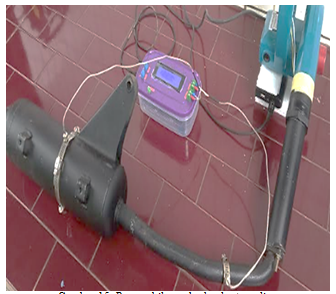Rancang Bangun Generator Thermal Dengan Pemanfaatan Limbah Panas Knalpot Motor Replika
Abstract
Abstract— Thermoelectric power plants are solid state devices that provide direct energy conversion from thermal energy due to a temperature gradient into electrical energy based on the "Seebeck effect", working by converting heat energy into electricity directly. In "Design of Thermal Generator with the Utilization of Heat Exhaust from Motor Replica". The test uses 4, TEP1-142 T300 in series, the test is carried out in several stages, namely no-load testing, the highest voltage obtained reaches 8 volts at (?T) the temperature difference between TH and TL 31 oC, the temperature is TH 65 oC and the temperature TL 34 oC. then using a load of 5 watt led lights experiencing a voltage drop, the maximum voltage is 5 volts with the power obtained 0.41 watts at 0.07 amperes, the test uses a boost converter, the voltage is as stable as 5 volts, where the thermoelectric voltage is V-in. must get a voltage of 3 volts. In this test the thermoelectric generator generates electrical power which is influenced by the temperature difference between TH and TL where the TL temperature must be lower than TH to get high power, the temperature at TL must always be maintained, therefore a good temperature cooling radiator is needed at TL, which is not more than 40 oC, the power generated can only turn on a 5volt lamp with a power of 0.34 watts which is very small because the number of thermoelectric modules also affects the power produced, the advantage in this test is that we can take advantage of the exhaust heat of motorized vehicles.
Downloads
References
[2] Sasmita, Sandy A. “Alternatif Pembangkit Energi Listrik Menggunakan Prinsip Termoelektrik Generator” Jurnal of Tesla Vol. 21 No. 1 . 2019
[3] Andreoni V, Galmarini S. European CO2 emission trends: a decomposition analysis for water and aviation transport sectors. Energy. 2012;45(1):595–602.
[4] Romina Rodriguez, Matthias Preindl, Ali Emadi, and James Cotton, “Maximum Power Point Tracking for Thermoelectric Generators with High Frequency Injection”, IECON 2015 conference, Japan, pp. 4127- 4132, 9-12 November, 2015.
[5] Wikipedia.org “Thermoelectric generator” [online] https://en.wikipedia.org/wiki/Thermoelectric_generator. 2021.
[6] Adroja, Mr Nikunj; B.Mehta, Prof Shruti; Shah, Mr Pratik. "Review of thermoelectricity to improve energy quality". 2 – Issue 3 (March-2015). JETIR.
[7] Babu, J. Kumar. “The Design of a Thermoelectric Generator and Its Medical Applications” ResearchGate. April 2019.
[8] Rusli, Adriyani. Djabbar, Rahmania. “Konversi Energi Panas Menjadi Energi Listrik Dengan Menggunakan Generator Termoelektrik”.Jurnal Logitech. 2020.
[9] Wikipedia.org “Energi termal” [online] https:// en.wikipedia.org/ wiki/Thermoelectric_generator. 2021.
[10] Wirawan, R. “Analisa Penggunaan Heat Pipe pada Thermoelectric Generator.” Skripsi. Teknik Mesin. FT-UI. 2012.
[11] Masrufaiyah, Sulistiono. Tri J. “Analisa Pengaruh Jumlah Plug Pada Kondenser Terhadap Effisiensi Dan Heat Transfer Yang Hilang Di PLTU unit 3 dan 4 PT. PJB UP. Gresik” Jurnal wahana teknik. Vol. 7, No. 1. Juni 2018
[12] Culp, A.W. “ Prinsip-Prinsip Konversi Energi", terjemahan Darwin Sitompul, Erlangga, Jakarta. 1996.
[13] Cengel, Yunus A. "Heat Transfer : A Practical Approach Second Edition”. McGraw-Hill. New York. 2003.
[14] Mojiri, “Spectral beam splitting for efficient conversion of solar energy-A review,” Science direct. 2013.
[15] Taylor, R.A. "Applicability of Nanofluids in High Flux Solar Collectors". Journal Of Renewable And Sustainable Energy 3, 023104. 2011.
[16] Riffat SB, Ma X. "Thermoelectrics: A review of present and potential applications". Appl Therm Eng. 2003.
[17] Sahin, Ahmet Z. Yilbas, Bekir S.. “Performance analysis of a thermoelectric power generator under volumetric constraint”. Transactions of the Canadian Society for Mechanical Engineering, Vol. 40, No. 1. March 2016.
[18] Power practical “How Do Thermoelectrics Work?” [online]. https: //powerpractical.com /pages /how -do-thermoelectrics-work. 2021.
[19] Cengel YA, Boles MA. "Thermodynamics: An engineering approach". 6th ed. McGraw-Hill press, New York. 2008.
[20] Ismail, Basel I. Wael H. Ahmed. “Thermoelectric Power Generation Using Waste-Heat Energy as Alternative Green Technology”. Recent Patents on Electrical Engineering. 2010.


This work is licensed under a Creative Commons Attribution-NonCommercial-NoDerivatives 4.0 International License.

This work is licensed under a Creative Commons Attribution 4.0 International License




